Part 3 - Variations of silvicultural systems
After completing this chapter you should:
- be aware of the most common variations of major silvicultural systems
- understand the ways that the major silvicultural systems can be modified to meet site-specific requirements
- understand the difference between a group shelterwood and a group selection
- be aware of the complexity involved in single tree selection systems.
Terms to remember:
- strip clearcut
- block clearcut
- uniform seed tree system
- grouped seed tree system
- uniform shelterwood
- strip shelterwood
- group shelterwood
- irregular shelterwood
- natural shelterwood
- nurse-tree shelterwood
- single tree selection
- group selection
- strip selection
Variations
Clearcut: Strip and block
Strip clearcut system
Strip clearcuts are used to harvest a stand over a period of three to seven years by removing several strips rather than harvesting the entire stand at once. Strip clearcutting was developed to take advantage of natural seeding from the leave-strips. In a pure sense, strip clearcut systems have mostly been used in Canada on a few site types with black spruce in boreal forests. The approach is being tried, along with strip shelterwoods, in boreal mixedwood types in northern Alberta as well.
A major concern associated with strip clearcuts is wind damage because the leave-strips expose much more edge for a short period than does one large clearcut. To avoid excessive windthrow, leave-strips should be at least 40 m wide, open only at one end, and harvested as soon as adjacent cleared strips are regenerated, thus minimizing exposure time. Also, boundaries of strips should be carefully located in healthy stands on deep, well-drained soils. Strip clearcuts can be designed in an alternate or progressive fashion.
Alternate strip clearcut
In alternate strip clearcut systems the cutting unit is cut in two stages. The initial cut produces long narrow clearcuts with leave-strips in between. Often leave-strips are narrower than first-pass strips because the leave-strips are cut once the regeneration is established in first-pass strips. The second-pass cuts will therefore need planting, but this requirement can be minimized.
Strip clearcuts, alternate or otherwise, are best oriented at right angles to prevailing winds. The width of the strips will depend on seedfall distances for the preferred species, wind hazard, and other factors.
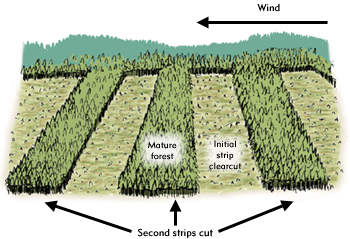
Progressive strip clearcut
The progressive strip clearcut system accomplishes the same objectives, in essentially the same manner, as the alternate strip clearcut but in three or more passes rather than in two.
Progressive strip clearcuts have two advantages over alternate strip clearcuts:
- The strips are progressively cut into the prevailing wind, reducing the exposed edge and windthrow.
- Less area in the final pass needs planting.
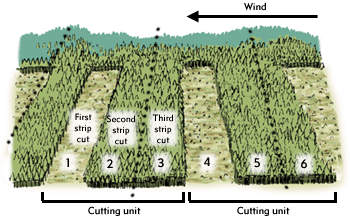
Block clearcut system
In block clearcut systems, natural regeneration from adjacent timber is not necessarily relied upon; instead, other considerations dictate block size and shape. These considerations include non-timber management objectives, forest type boundaries, terrain features, windthrow risk, and the limitations of the harvesting equipment to be used.
Sad but true: The clearcut 'system'?
The "clearout" system, also know as the cut-and-run system, should not be confused with a silvicultural system. Throughout the early days of logging in any pristine North American forest, whole valleys and large tracts of private land were systematically clearcut from one end to another without any thought to regeneration, non-timber values, or sustainability. The central concept to this approach was that there was always somewhere else to go. Of course that somewhere else was often far away. This was evident as the loggers in the US moved from New England to the Lake States, to the Pacific Northwest. Eventually, the loggers found themselves staring at the Pacific Ocean with nowhere else to go.
The clearout system has given clearcutting a bad name for some time. Indeed, considerable effort has been expended in British Columbia on reforestation of backlog not satisfactorily restocked (NSR) land which was cut before obligations were legislated. Unlike the pure exploitation of the clearout system, the clearcut silvicultural system manages a stand for the long term.
Seedtree: Uniform and grouped
The major types of seed tree systems can be differentiated based on the arrangement of the seed trees.
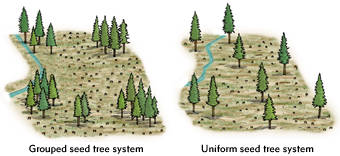
Uniform seed tree system
In uniform seed tree systems, individual trees are more or less uniformly distributed throughout the block. This system is the most common seed tree system in BC. Often more trees are left than the number required to meet regeneration requirements. This provides an economic opportunity for a removal cut or can satisfy other resource objectives, such as wildlife habitat.
Grouped seed tree system
In a grouped seed tree system, seed trees are left in the block in small patches. These patches may be arranged in irregular groups or in strips. Generally, seedfall distance is a major consideration for determining distances between patches or groups of seed trees, although non-timber objectives may also play a part.
Quote:
The size of the seed group has of course great influence in determining its windfirmness.
Ralph Hawley (1929)
Sad but true: The "weed tree" system is not a silvicultural system. As we have seen, intent helps to define a silvicultural system. However, silviculture hinges on proper application of silvics knowledge on the ground. Many well-intended seed tree systems in the past were actually weed tree systems in disguise. Unfortunately, non-vigorous, spindly leave-trees were favoured rather than those windfirm, desirable seed sources that are used in the seed tree system of today. In addition, some of these past weed tree systems had no site preparation and/or no thought given to rapidly developing brush complexes. The moral of this story is: you can leave a few trees scattered in a block, but you may be promoting a weed tree system if it only relies on good intentions to procure regeneration.
Another variation of the weed tree system can sometimes be found where undesirable species are left behind simply because they weren't worth harvesting. If these species are prolific seed-producers and they find an acceptable seedbed, a wonderful crop of undesirable trees may result. We have grown some exceptional crops of cottonwood and birch by accident using weed tree systems rather than by design, using seed tree silvicultural systems.
P.S. Groups may be more resilient to windthrow than uniformly distributed trees. Suggest some other reasons why you may want to use a grouped seed tree pattern rather than a uniform seed tree pattern.
Shelterwood: Uniform, strip, group, irregular, natural and nurse-tree
Uniform shelterwood system
In uniform shelterwood systems, treatments are applied uniformly over the same stand: this is the standard type of shelterwood. The uniform system is the system that most often relies on a series of preparatory cuttings (thinnings) to ready the stand for the regeneration/establishment cutting by encouraging crown expansion, and promoting windfirmness and cone production.
Mathews (1989) notes that in Europe the practice of making preparatory cuttings 2-10 years before the regeneration cutting has generally been replaced by a schedule of preparation thinnings throughout the life of the stand to better encourage the crown expansion and windfirmness required for the establishment cutting.
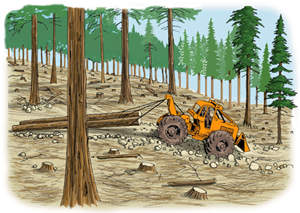
In BC we are faced with the prospect of entering mature to over mature natural stands for the first time to attempt natural shelterwoods. If we do not have well-established dominant trees to work with, we may face problems in areas of high wind exposure.
Strip shelterwood
Harvesting entries in a strip shelterwood are made in relatively narrow strips that advance progressively through a portion of the block over the regeneration period. In this way initial harvesting occurs in the stand as uniformly staggered linear strips. Future harvesting strips are added beside the initial strips and progress into the wind until the entire block is harvested, usually within a normal even-aged regeneration period (10-25 years). Harvesting in each strip may occur gradually and include a preparatory, regeneration and removal cut, following in sequence, or strips may be oriented to use the side shade from adjacent timber.
Strip shelterwoods evolved in Europe to provide some protection from windthrow. Establishment cuts (preceded possibly by preparatory cuts) and removal cuts are made in narrow strips running perpendicular to, and advancing progressively against, the prevailing wind direction.
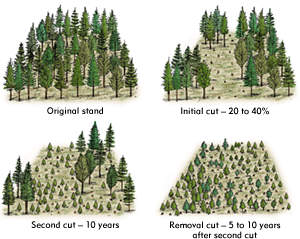
This system contains many possible modifications, including advancing narrow clear-felled strips, which use side shade for protection, and the wedge shelterwood, which orients strips into a wedge shape with the apex into the wind for further protection from windthrow.
Note: The beech forest of Sihlwald in Zurich, Switzerland, was classically managed for over 400 years under a group shelterwood system. In the early 1900s this forest inspired Gifford Pinchot, the first chief forester of the US Forest Service. In 1989, public pressure forced city officials to limit cutting to commercial thinning.
Note: The strip and group shelterwood system was developed chiefly in Bavaria by H. von Huber, chief of the Bavarian Forest Service. It is now widely used in central Europe.
Quote:
There is likely to be more injury to reproduction from removal of the old timber in the group than in the strip shelterwood method, because of the more irregular way in which old timber is intermingled with young growth.
Ralph Hawley (1929)
Variations on the simple group shelterwood
A German variation (Gruppenschirmschlag) mixes the simple group and the strip shelterwood systems. This system uses existing gaps with advance regeneration by initiating a regeneration cutting in a ring around the existing gaps. Additional gaps may be created, each followed by a regeneration-cut ring, once regeneration is established. The regeneration-cut ring continues to expand in successive passes, with removal cuttings following it, once regeneration is established. Eventually, the shelterwood expands to occupy the whole stand.
As you may imagine, woodflow and skid trail networks must be laid out carefully ahead of time to minimize damage to developing regeneration. In windy areas, exposed stand edges should be anchored by windfirm trees and cutting should be modified to progress into the wind as much as possible.
The strip and group system combines elements of the two approaches. First, small groups are opened within a strip to encourage advanced patches of regeneration. After the regeneration has started, the groups are then opened wider and a uniform regeneration felling is made between the groups. A third entry to further widen the groups may occur before the removal cut, providing for regeneration of species mixes, including shade-intolerant species. Mathews (1989) provides a good discussion of all variations of shelterwoods.
Irregular shelterwood system
Irregular shelterwoods are defined by timing of regeneration establishment not by spatial arrangement. The regeneration period for the stand is extended so long that the new stand is not really even-aged. Although the regeneration period may extend up to 50 years over the whole cutting unit, the stand does not have three or more age classes, as in an uneven-aged stand. Therefore, the stand structural objective is between the even-aged and uneven-aged structure.
This system may be executed the same way as a shelterwood with reserves if the overstorey is retained for the entire rotation. The difference is that with an irregular shelterwood, the seedbed is receptive to regeneration for a long time and the intent is to continue to procure regeneration for much longer than the normal regeneration period.
"Irregular" refers to the subsequent variation in tree heights in the new stand. This system tends to draw on elements from other systems, notably group and single tree selection. While our example shows retained leave-trees scattered individually through a block, felling in groups is common. The groups are expanded slowly outward until they coalesce at the end of the regeneration period (50 years or longer). The irregular shelterwood system is very versatile and can be applied in uniform, strip, or group spatial variations (i.e., irregular group or irregular strip shelterwood).
This irregular shelterwood system is usually used to promote structural diversity while maintaining the simplicity of even-aged management. Objectives for aesthetics, wildlife, biodiversity, or hydrological green-up may be compatible with this system.
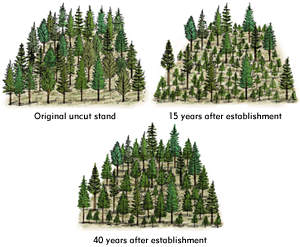
Quotes:
Of all the classical silvicultural systems, some form of the group systems and the irregular shelterwood system have the best potential for geriatric silvicultural prescriptions in over-mature Canadian conifer ecosystems.
Gordon Weetman (1996)
The irregular shelterwood is the most recent silvicultural system to have been developed and has replaced all the others except the selection system in Switzerland.
John Mathews (1989)
Natural shelterwood system
Often associated with clearcutting and called "overstorey removal," this system may better be called a shelterwood because the regeneration is established naturally under the shelter of an overstorey.
Some foresters express concern over labelling what will look like a regenerated clearcut a type of shelterwood. This concern relates to the difference between harvesting patterns, which are short term, and silvicultural systems, which are longterm. All shelterwoods or seed tree systems will look like regenerated clearcuts after removal cutting, unless some "reserve trees" have been retained.
By definition, a natural shelterwood may only be used once when some unmanaged stands come under management. However, these types of stands may be quite suitable for continued management using a shelterwood system over subsequent rotations.
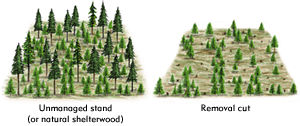
Applying a natural shelterwood system: Can you suggest some stand types in your area that may be suitable for the application of a natural shelterwood system?
Nurse-tree shelterwood system
These systems encourage development of two stories in a stand, each containing a different species or mix of species. With these systems, intolerant, seral species tend to make up the overstorey with tolerant, climax species making up the understorey (see diagram).
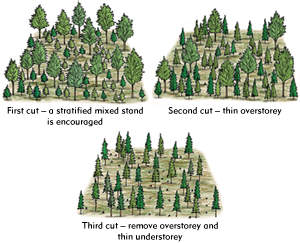
The nurse-tree shelterwood system may be used to maintain a component of shade-tolerant species on sites where these species require protection, or on cleared sites where desired tolerant species grow too slowly to compete successfully with other vegetation in the open.
Establishment of a hardy, shade-intolerant, exposure-tolerant species as a nurse-crop may precede establishment of the more sensitive, shade-tolerant species. The understorey of shade-tolerant trees may be established either naturally or artificially. However, a proper understanding of natural succession dynamics and species requirements is essential for success.
The spatial arrangement of leave-trees
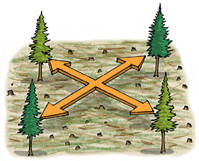
- uniform shelterwood system
- strip shelterwood system
- group shelterwood system
The timing of overstorey removal
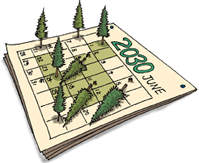
- irregular shelterwood
- natural shelterwood
The management of different species indifferent canopy layers
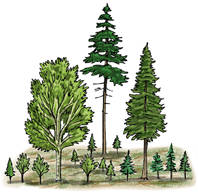
- nurse-tree shelterwood
Single tree selection, group selection, strip selection
Single tree selection
Single tree selection removes individual trees of all size classes more or less uniformly throughout the stand to maintain an uneven-aged stand and achieve other stand structural objectives. While it is easier to apply such a system to a stand that is naturally close to the uneven-aged condition, single tree selection systems are prescribed for even-aged stands, although numerous preparatory cuttings must be made to create a stand structure where the system can truly be applied.
Once the uneven-aged structure approximates the balanced condition, the single tree selection system generally produces a complex mixture of small, even-aged clumps which are thinned over time to theoretically produce one mature tree. In theory these clumps should yield at least one mature tree of the specified maximum diameter, although in practice these clumps are often larger.
New regeneration develops in small scattered openings created theoretically in small gaps with an area equivalent to the crown spread of a single mature tree. In practice these gaps are often larger, created through the removal of several mature trees. Since regeneration is always being recruited and larger mature trees are scattered, or in very small groups, these stands appear quite open, with many gaps. The system is generally used for the most tolerant species in an area. Using the single tree selection system to encourage species mixtures requires effort, especially where some less tolerant seral species are desired. Such stands must be opened considerably for this system to work.
Since these stands are a confusing jumble of age classes, regulation of these stands tends to be complex. Usually guidelines for residual stocking, maximum diameter, diameter distribution (usually expressed by a "q-ratio"), and cutting cycle are used during each entry. Smith (1993) warns against attempting to create mini, sustained yield units at the stand level. He suggests that foresters should instead focus on maintaining a continuous stock of larger trees, without excessive concern about perfectly balancing age classes. Nyland (1996) also warned about relying on the pure mathematical relationship defined by a q-ratio for diameter distributions, pointing out that q-distributions never remain stable even through one cutting cycle.
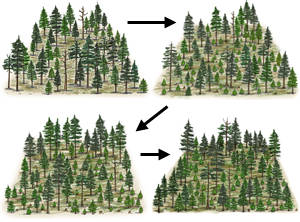
Single tree selection over time
However, Nyland does recommend using all of the classic selection parameters, including q-ratios, as interim guidelines. Both Smith and Nyland suggest close monitoring and periodic remeasurement to follow selection stands through their cutting cycles such that parameters can be adjusted to fit the biological reality with the management objectives. All authors encourage foresters to never forget the basic tenets for successful single tree selection: to provide sufficient gaps for regeneration and to maintain vigour throughout the stand.
For more information on these complex systems, please refer to Appendix 2.
Sad but true: After World War II in British Columbia some controls were placed on harvesting in the Southern Interior. The BC Forest Service brought in the 60/40 rule, which dictated that only 60% of a stand could be harvested, while 40% must remain uncut. The rule was imposed by cruising stands to be sold, developing stand and stock tables, and devising a diameter limit to conform to the 60/40 rule.
What this meant was that all the trees above a given diameter were harvested leaving the smallest trees to make up the 40% uncut portion: in effect - "big-tree selection." While the BC Forest Service experimented with some highly commendable marking guidelines in the 1950s, the high cost of marking prompted a return to the diameter limit approach, which was much easier to monitor.
The end result was no different than the exploitive selective logging which only removed the most desirable trees. Stands were logged and left to languish in a much poorer condition than before harvesting, with overstocking of small, non-vigorous, often poorly formed, and unhealthy trees. Selection systems demand diligent care and attention to maintenance of stand structure, health, and vigour over the long term. The many volume-based tenures in place throughout the Southern Interior do not provide this long-term focus at the stand level and make successful application of selection systems difficult. However, big-tree selection is not a silvicultural system and should have no place in forest management.
Quotes:
Perverted applications of the single tree selection system in the wrong situations have left a disreputable legacy in the minds of many. A body of broad generalizations and misconceptions has provided the first operational hurdle to successful application of selection management: a poor attitude.
Rolan Becker (1995)
Although classical uneven-aged stands are great places to learn about uneven-aged management sometimes you have to make it work (or start to work) when the existing stand structure isn't totally cooperative. That's when following the textbooks gets tough. That's when experience counts.
Mike Znerold (1990)
Group Selection
Group selection systems also promote uneven-aged stands with clumps of even-aged trees well distributed throughout the cutting unit. Unlike single tree selection, however, these even-aged groups are large enough to accommodate some shade-intolerant seral species in addition to more tolerant climax species. Small gaps or openings are created on short intervals to develop into a mosaic of at least three or more age classes throughout the stand (see the diagram).
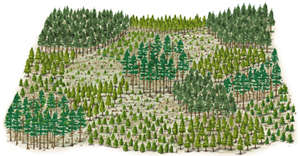
Remember that the choice of group or single tree selection must consider the resource management objectives at all levels and the existing stand and site conditions. Because of stand-level advantages, group selection or any other system cannot be viewed as a panacea in areas with many conflicting management objectives. The implications of using a broad application of one silvicultural system over a large area could be serious for one or more management objectives.
Advantages of group selection system over single tree selection
Basically the group selection system is easier to administer and treat than single tree selection. The simplest types of group selection systems create definite gaps in the forest canopy. These systems fit ecologically with "gap-regenerated" stands, which tend to be common in some unmanaged stand types. If gaps are large enough, the entire spectrum of local vegetation may regenerate within them. This may encourage a diverse habitat for wildlife and promote biodiversity.
Size of group openings
Some authors suggest that group selection systems may have openings as small as that created through the removal of two or three trees, up to as large as several tree lengths across (Nyland 1996). However, single tree selection system, where opening size approximates that created through the removal of a single mature tree, is rarely applied on the ground. Instead, single tree selection often removes clumps of several mature trees, potentially confusing it with this definition of group selection. Also, some authors speak of group/single tree selection combinations and patch selection systems, where single tree selection is combined with small fixed-area patches at widely scattered locations (Nyland 1996).
As you can see, the array of terms used for uneven-aged systems can become quite confusing. Therefore, it is perhaps simpler to recognize a continuum of group or clump sizes between single tree selection and group selection. Use of the terms may vary among managers depending on the species they manage and the ecology of their sites. At the margin between the two systems the name chosen to describe them probably doesn't matter too much. It is appropriate to call selection systems single tree selection when the group openings created are so tiny that simple area based regulation is impractical and the classic uneven-aged parameters (q-ratios,etc.) must be used. Some managers may still call such systems group selection or small-group selection, although this is probably not a huge issue.
At the other end of the group-size question, a group selection with 5 ha openings to harvest a 200 ha stand stretches the definition of group selection too far. Authors worldwide agree that a group becomes a clearcut ecologically when most of the opening (greater than 50%) starts to have the same environmental regime as a large clearcut. The opening size will depend on the biological requirement of the preferred tree species and other resource objectives. However, if the openings become larger then several tree lengths, they may approach the clearcut environment. The Ministry of Forests therefore defines group selection as having openings of two tree lengths or less in width. In spite of this administrative definition, ecological considerations related to the influence of the stand edges would depend on aspect, slope, and other terrain features which may influence the angle of solar radiation and windflow.
Quote:
Clearcutting: The harvesting of all trees in a single cut from an area of forest large enough so that the "forest influence" is removed from the majority of the harvested area.
Hamish Kimmins (1992)
Activity: Compare Group Shelterwood to Group Selection
Do you understand the difference between group selection and group shelterwoods? Study the following diagram and describe the differences.
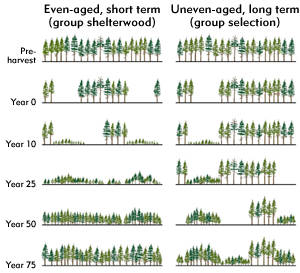
Strip selection
The strip selection system manages age classes in regular strips rather than unspecified group shapes. This system was developed to provide advantages for managing windthrow. As with other systems using strips, the strips should be oriented perpendicular to the prevailing wind. If cutting proceeds systematically against the wind, the stand develops an aerodynamic shape, with further advantages for wind protection (see diagram).
Again, this system differs from the strip shelterwood system in that the strips are removed over three or more passes to give a truly uneven-aged stand and their removal occurs much more slowly. The cutting period between passes will be 15-30 years, depending on the number of passes, and a regular rotation is needed to complete all passes.
As in the strip shelterwood system, the strip width in the strip selection is sufficiently narrow to create an environment that differs substantially from a clearcut and produces strips that are too small to qualify as individual stand units. Because they have the advantage of one long dimension, strips tend to be narrower than groups. Where mature timber heights are 30-35 m, strips widths of 15-50 m will be used, depending on orientation and objectives. These systems are well suited to small skyline systems.
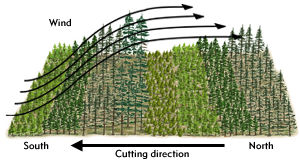
Quote:
What mighty battles have I seen and heard waged between the trees and the west wind - an Iliad fought in the field of air.
Edith M. Thomas
Case Study (see appendix 1)
|
Pre-harvest stand: |
western larch/Douglas-fir/lodgepole pine/western redcedar - in equal proportions |
|
Prescribed silvicultural |
species selection |
|
Cutting specifications: |
cut all lodgepole pine |
|
Regeneration method: |
natural |
|
Preferred species: |
western larch and Douglas-fir |
|
Site preparation: |
none (harvest disturbance) |
|
Other: |
regeneration survey in five years |
Activity: Stand structural changes over time - the impact of reserves
The only difference in the two diagrams below is that the strip selection system on the right contains scattered reserve trees. What strikes you about the difference between the two systems?
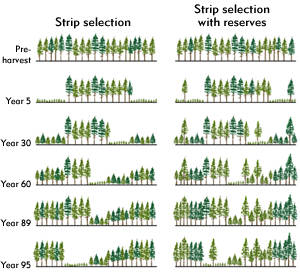
Self test questions
- Explain the difference between the two types of strip clearcut systems.
- In what Canadian stand type(s) has strip clearcutting been mostly applied in? In what other British Columbia stand types do you think strip clearcutting might be most applicable?
- Describe the two types of seed tree systems.
- Explain the difference between the current European application of the uniform shelterwood system and the general approach that must be used in BC.
- Draw a diagram of a strip selection system and describe the harvesting entries as per their intent. Suggest some variations of this system.
- Describe a simple group shelterwood and two variations of this approach.
- What is an irregular shelterwood and what are some advantages of this system?
- Describe the difference between a natural shelterwood and a nurse-tree shelterwood.
- What are the two most important aspects of single tree selection structural regulation?
- Describe some advantages of group selection over single tree selection.
- How does a strip selection differ from a strip shelterwood?
